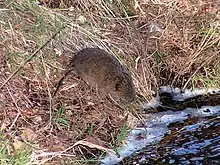Arvicola
The water voles are large voles in the genus Arvicola. They are found in both aquatic and dry habitat through Europe and much of northern Asia. A water vole found in Western North America was historically considered a member of this genus, but has been shown to be more closely related to members of the genus Microtus.[1][2] Head and body lengths are 12–22 cm, tail lengths are 6.5–12.5 cm, and their weights are 70–250 g. The animals may exhibit indeterminate growth. They are thick-furred and have hairy fringes on their feet that improve their swimming ability.
| Water voles Temporal range: Early Pleistocene - Recent | |
|---|---|
 | |
| Arvicola amphibius | |
| Scientific classification | |
| Domain: | Eukaryota |
| Kingdom: | Animalia |
| Phylum: | Chordata |
| Class: | Mammalia |
| Order: | Rodentia |
| Family: | Cricetidae |
| Subfamily: | Arvicolinae |
| Tribe: | Arvicolini |
| Genus: | Arvicola Lacépède, 1799 |
| Type species | |
| Mus amphibius | |
| Species | |
A 2021 phylogenetic study using mtDNA found that Arvicola may not belong with the rest of its namesake tribe Arvicolini, but rather forms a sister group to the tribe Lagurini.[3]
Species
There are three species as listed by the IUCN:
- European (or northern) water vole (A. amphibius or A. terrestris)[4]
- Southwestern (or southern) water vole (A. sapidus)[5]
- Montane water vole (A. scherman)[6]
The American Society of Mammalogists recognizes four species, with A. italicus and A. persicus being split off from A. amphibius:[7]
- Eurasian water vole (A. amphibius)
- Italian water vole (A. italicus)
- Persian water vole (A. persicus)
- South-western water vole (A. sapidus)
References
- Conroy, C. J. and J. A. Cook. 2000. Molecular systematics of a Holarctic rodent (Microtus: Muridae). Journal of Mammalogy, 81:344-359.
- Musser, G. G. and M. D. Carleton. 2005. Superfamily Muroidea. pp. 894–1531 in Mammal Species of the World a Taxonomic and Geographic Reference. D. E. Wilson and D. M. Reeder eds. Johns Hopkins University Press, Baltimore.
- Abramson, Natalia I.; Bodrov, Semyon Yu; Bondareva, Olga V.; Genelt-Yanovskiy, Evgeny A.; Petrova, Tatyana V. (2021-11-19). "A mitochondrial genome phylogeny of voles and lemmings (Rodentia: Arvicolinae): Evolutionary and taxonomic implications". PLOS ONE. 16 (11): e0248198. doi:10.1371/journal.pone.0248198. ISSN 1932-6203. PMC 8604340. PMID 34797834.
- Batsaikhan, N.; Henttonen, H.; Meinig, H.; Shenbrot, G., Bukhnikashvili, A., Hutterer, R., Kryštufek, B., Yigit, N., Mitsain, G. & Palomo, L. (2021) [amended version of 2016 assessment]. "Arvicola amphibius". IUCN Red List of Threatened Species. 2021: e.T2149A197271401. doi:10.2305/IUCN.UK.2021-1.RLTS.T2149A197271401.en.
{{cite journal}}: CS1 maint: multiple names: authors list (link) - Rigaux, P.; Vaslin, M.; Noblet, J.F.; Amori, G.; Palomo, L.J. (2008). "Arvicola sapidus". IUCN Red List of Threatened Species. 2008: e.T2150A9290712. doi:10.2305/IUCN.UK.2008.RLTS.T2150A9290712.en.
- Cassola, F. (2017) [errata version of 2016 assessment]. "Arvicola scherman". IUCN Red List of Threatened Species. 2016: e.T136766A115519839. doi:10.2305/IUCN.UK.2016-3.RLTS.T136766A22358636.en.
- Mammal Diversity Database (2023). "Mammal Diversity Database (Version 1.11) [Data set]". Zenodo. doi:10.5281/zenodo.7830771.
Further reading
- Nowak, R. M. 1999. Walker's Mammals of the World, Vol. 2. Johns Hopkins University Press, London.
- Townsend, C., Begon, M. and Harper, J.L. 2003. Essentials of Ecology: second edition. Blackwell Publishing, Oxford.